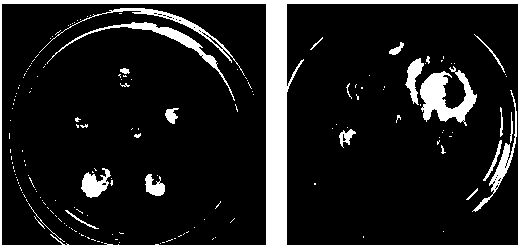Method for isolated culturing of root nodule endophytes of sea buckthorn plants
A seabuckthorn root nodule, isolation and culture technology, applied in the isolation and culture of plant root nodule endophytes, and in the field of isolation and culture of seabuckthorn plant root nodule endophytes, can solve the problem of large nutritional differences, inability to cultivate microorganisms, and small number and types of endophytes and other problems, to achieve the effect of increasing species and quantity, multi-endophyte resources, and shortening time
- Summary
- Abstract
- Description
- Claims
- Application Information
AI Technical Summary
Problems solved by technology
Method used
Image
Examples
Embodiment 1
[0015] (1) Surface disinfection of seabuckthorn root nodule samples
[0016] Select fresh and tender seabuckthorn root nodules, and carry out surface disinfection on seabuckthorn root nodules: take spare seabuckthorn root nodules, rinse them with running tap water in turn, and wash away impurities such as sediment with a brush, then rinse with sterile water for 3 to 5 times , surface disinfection with 75% ethanol for 8-10 minutes, surface disinfection with 1% NaClO solution for 5-7 minutes, and then rinse with sterile water for 3-5 times (avoid damage to the surface of seabuckthorn root nodule samples during the entire operation).
[0017] (2) Isolation and cultivation of endophytes
[0018] Preparation of seabuckthorn root extract: Wash and chop the seabuckthorn root, mix it with distilled water at a volume ratio of 1:1, boil it, simmer for about 1 hour, filter, take the clear liquid, and sterilize it at 121°C for storage for later use.
[0019] Isolation and cultivation of ...
Embodiment 2
[0027] (1) Surface disinfection of seabuckthorn nodule samples: same as in Example 1.
[0028] (2) Isolation and cultivation of endophytes: Isolation and cultivation of endophytes: Cut the root nodules into 1-2 mm thin slices with a sterile scalpel, insert them into three different agar media, culture them at 28°C, and wait for the nodules to grow. After the flake grows bacteria, it is picked onto the plate with an inoculation needle for further purification.
[0029] The endophytic fungus uses PDA medium, and sea buckthorn root extract is added to the PDA medium (the volume ratio of medium to sea buckthorn root extract is 1:15), and the plate is cultured at 28°C for 5 days.
[0030] Beef extract peptone medium was used for endophytic bacteria, and sea buckthorn root extract was added to the beef extract peptone medium (the volume ratio of medium to sea buckthorn root extract was 1:15), and the plate was cultured at 28°C for 5 days.
[0031] The endophytic actinomycetes use G...
Embodiment 3
[0036] (1) Surface disinfection of seabuckthorn nodule samples: same as in Example 1.
[0037] (2) Isolation and cultivation of endophytes: Isolation and cultivation of endophytes: Cut the root nodules into 1-2mm thin slices with a sterile scalpel, insert them into three different agar mediums, culture them at 30°C, and wait for the nodules to grow. After the flake grows bacteria, it is picked onto the plate with an inoculation needle for further purification.
[0038] The endophytic fungus uses PDA medium, and sea buckthorn root extract is added to the PDA medium (the volume ratio of medium to sea buckthorn root extract is 1:18), and the plate is cultured at 30°C for 3 days.
[0039] Beef extract peptone medium was used for endophytic bacteria, and sea buckthorn root extract was added to the beef extract peptone medium (the volume ratio of medium to sea buckthorn root extract was 1:15), and the plate was cultured at 30°C for 3 days.
[0040] The endophytic actinomycetes use ...
PUM
 Login to View More
Login to View More Abstract
Description
Claims
Application Information
 Login to View More
Login to View More - R&D
- Intellectual Property
- Life Sciences
- Materials
- Tech Scout
- Unparalleled Data Quality
- Higher Quality Content
- 60% Fewer Hallucinations
Browse by: Latest US Patents, China's latest patents, Technical Efficacy Thesaurus, Application Domain, Technology Topic, Popular Technical Reports.
© 2025 PatSnap. All rights reserved.Legal|Privacy policy|Modern Slavery Act Transparency Statement|Sitemap|About US| Contact US: help@patsnap.com


